August 2005
Conrad-Johnson
ACT2 Preamplifier: Measurements
All preamplifier measurements are performed
independently by BHK Labs. Please click to
learn more about how we test preamplifiers there. All measurement data and graphical
information displayed below are the property of SoundStage! and Schneider
Publishing Inc. Reproduction in any format is not permitted.
- Measurements were made at 120V AC line voltage. Measurements
made on the left channel unless otherwise noted.
- Gain, volume at maximum:
IHF loading, Lch/Rch = 10.49X, 20.4dB / 10.77X, 20.6dB
Instrument loading, Lch/Rch = 9.98X, 20.0dB / 10.24X, 20.1dB
- IHF sensitivity, input volts for standard IHF output of
0.5V:
IHF loading, Lch/Rch: 50.1mV / 48.8mV
- Output noise versus bandwidth and volume-control position,
wideband/A weighted:
At maximum, gain @ 99 = 557.9µV / 215.6µV
Worst case, gain @ 99 = 557.9µV / 215.6µV
Unity gain, gain @ 76 = 309.4µV / 20.6µV
Listening level, gain @ 40 = 449.9µV / 5.4µV
- AC line current draw at idle: 1.0A.
- Output impedance at 1kHz: 516 ohms.
- Input impedance at 1kHz:
Gain at max (99), Lch/Rch = 67.1k ohms / 68.0k ohms
Gain at 40, Lch/Rch = 12.0k ohms / 12.0k ohms
- This preamplifier inverts polarity.
General
The Conrad-Johnson ACT2 preamplifier utilizes two 6N30P
tubes in parallel for each channel, forming a single amplifying stage for its signal
circuitry. A switched resistor network is used for the volume control. Solid-state
regulators are employed to supply high voltage and heater voltages for the tubes.
Chart 1 shows the frequency response of the ACT2 with the
volume control set for unity gain (76) for 0.5V input and IHF loading. The two channels
are tracking within 0.25dB at this point on the volume control. Also shown in Chart 1 is
the frequency response with an instrument load. The bandwidth with the instrument load is
about 200kHz.
In Charts 2a and 2b, the frequency response of the preamp
is shown for the volume at maximum (99) and at a typical listening position (40). Volume
control tracking at these settings is also within about 0.25dB.
Chart 3 shows how total harmonic distortion varies with
input level and frequency for both IHF and instrument loading. Unique in my experience is
the identical nature of the distortion curves for 20Hz, 1kHz, and 20kHz. This is superb
performance.
A spectrum of the distortion and noise residual of a 1kHz
test tone at 0.5V output with IHF loading is plotted in Chart 4. AC line hum harmonics
here are rather numerous. The signal frequency harmonics consist of just the second
harmonic.
| Chart 1 - Frequency
Response at Unity Gain with IHF and Instrument Loading |
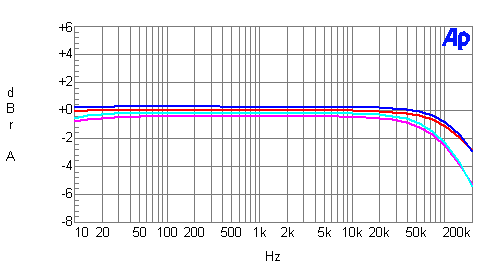
IHF loading
Magenta line = left channel
Cyan line = right channel
Instrument loading
Red line = left channel
Blue line = right channel
| Chart 2 - Frequency Response as a
Function of Volume Control Setting |
Chart 2A - gain at maximum
(99)
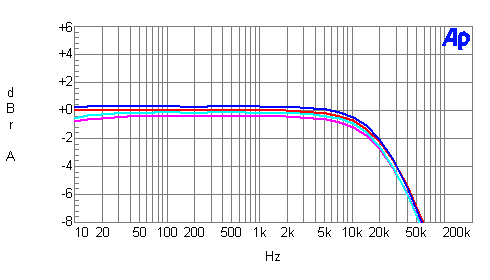
IHF loading
Magenta line = left channel
Cyan line = right channel
Instrument loading
Red line = left channel
Blue line = right channel
Chart 2B - gain at 40
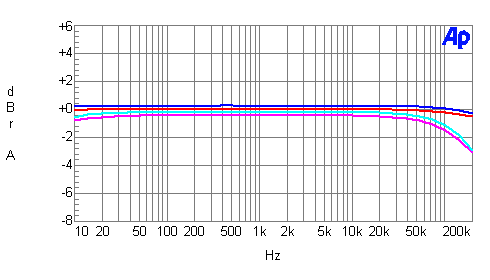
IHF loading
Magenta line = left channel
Cyan line = right channel
Instrument loading
Red line = left channel
Blue line = right channel
| Chart 3 - Distortion
as a Function of Output Voltage and Frequency |
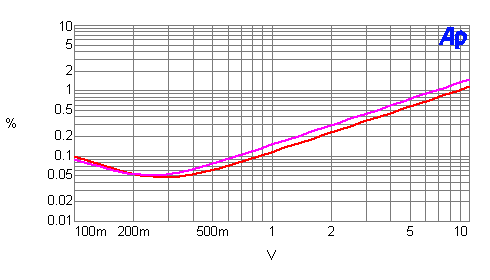
IHF loading
Magenta line = 20Hz, 1kHz, 20kHz
Instrument loading
Red line = 20Hz, 1kHz, 20kHz
| Chart 4 - Distortion and
Noise Spectrum |
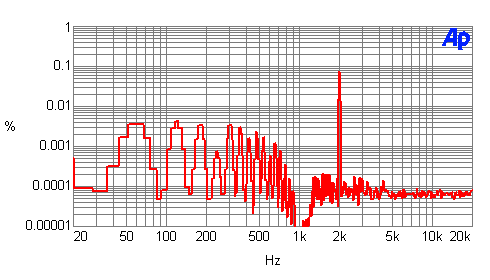
Red line = spectrum of 1kHz test-signal distortion and AC-line harmonics
|
![[SoundStage!]](../titles/sslogo3.gif) Home Audio
Home Audio ![[SoundStage!]](../titles/sslogo3.gif) All Contents
All Contents



